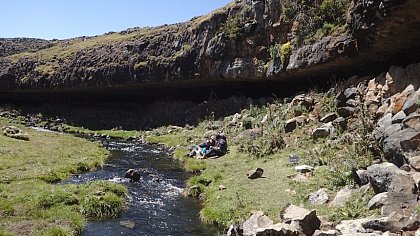Middle Stone Age foragers resided in high elevations of the glaciated Bale Mountains, Ethiopia

View of Fincha Habera rock shelter (Bale Mountains, SE
Ethiopian Highlands) which has served as residential site
of Middle Stone Age foragers. (Photo: G. Ossendorf)
Recent archaeological research has produced evidence of the earliest human occupation of high-altitude habitats in the Andes and the Tibetan Plateau. Ossendorf et al. now present the oldest evidence of human settlement and adaptation to areas above 4000-meter elevation in Africa (see the Perspective by Aldenderfer). Their excavations at a rock shelter in the Bale Mountains of Ethiopia reveal obsidian artifacts and faunal remains, including abundant burnt bones, mostly of giant mole-rats. The findings reveal the environmental conditions and show how Late Pleistocene humans adapted to the harsh environments of these glaciated high-altitude African landscapes.

Studies of early human settlement in alpine environments provide insights into human physiological, genetic, and cultural adaptation potentials. Although Late and even Middle Pleistocene human presence has been recently documented on the Tibetan Plateau, little is known regarding the nature and context of early persistent human settlement in high elevations. Here, we report the earliest evidence of a prehistoric high-altitude residential site. Located in Africa’s largest alpine ecosystem, the repeated occupation of Fincha Habera rock shelter is dated to 47 to 31 thousand years ago. The available resources in cold and glaciated environments included the exploitation of an endemic rodent as a key food source, and this played a pivotal role in facilitating the occupation of this site by Late Pleistocene hunter-gatherers.

Fincha_Habera_Science_german
Fincha_Habera_Science_german.docx
(21.9 KB) vom 23.09.2019
Fincha_Habera_Science_english
Fincha_Habera_Science_english.docx
(16 KB) vom 23.09.2019
newspaper article
- Der Tagesspiegel (09.08.2019)
- ScienceDaily (08.08.2019)
- Deutschlandfunkinterview with Götz Ossendorf (09.08.2019)
- The New York Times (08.08.2019)
- SWR2 Interview with Götz Ossendorf (09.08.2019)
- BR24 (09.08.2019)
- Bild (09.08.2019)
- Süddeutsche Zeitung (11.08.2019)
- Spiegel (09.08.2019)
- ZDF (09.08.2019)
- CNN (08.08.2019)

